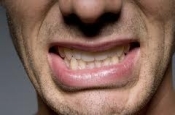Abfractions are difficult to explain to patients. Here is a simplified explanation
“Doctor, I always thought these notches are from brushing too hard. They are painful and I have them on my teeth on both sides. What causes them?”
Here is a simplified explanation:
An abfraction occurs on the lower part of the crown of a tooth, near the gum line.
The enamel covering the crown tapers down to its thinnest there. When the occlusion (bite) is not balanced, there will be uneven pressures on the biting surfaces of teeth. Those pressures cause a torque on the tooth which produces a slight bend at the center where the crown meets the root. As the tooth keeps bending, the thin enamel at the bottom of the crown, near the gum line, chips away. The sensitive “dentin” surface inside the enamel is now exposed. Vigorous, improper teeth brushing will then wear away the unprotected dentin and the notches will grow deeper and larger.
The dentin also becomes vulnerable to acid erosion from foods such as citrus.
The uneven bite pressures also cause a loss of gum and bone attachment around the roots so the roots become progressively exposed adding to the acute sensitivity to touch and cold. Advanced effects can be fracture of the tooth at the crown-root junction, tooth mobility and serious gum disease.
Abfractions can resemble other conditions like decay or toothbrush abrasion, but the treatment is more specific. The treatment, after diagnosing the cause as a bite dysfunction, consists of balancing the bite to equally and properly distribute the pressures and then to restore the lost tooth structure. An occlusal guard may be required. About 25% of the population clench or grind their teeth at night (and are completely unaware of it!). Obviously, the earlier this condition is discovered, the less damage to the teeth and bone will have occurred. In advanced cases crowns may need to be placed to protect the weakened teeth. There are some cases where orthodontic treatment may be necessary.
Abfractions are non-carious cervical lesions (NCCL) caused by flexural forces, usually from cyclic loading; the enamel, especially at the cementoenamel junction (CEJ), undergoes this pattern of destruction by separating the enamel rods. Studies show that within the same patient, teeth with abfractions presented more gingival attachment loss than those without abfractions. However, associations were not demonstrated between premature contacts in centric relation (PCCR) and the presence of abfractions or increased attachment loss.
Abfractions are common in patients with Obstructive Sleep Apnea. Nocturnal bruxism plays a major role.
QUIZ
True/False
- Abfractions are usually caused by improper teeth brushing. (F)
- Abfractions are a specific type of dental decay. (F)
- Correction of an abfraction requires more than just a cervical filling. (T)
- Nutrition plays a role in worsening abfractions. (T)
Multiple Choice
Which are correct?
- .Abfractions occur primarily on the facial surfaces of teeth.
- A porcelain veneer can have an abfraction.
- Abfractions occur only on maxillary teeth.
- An abfraction may be able to cause a separation fracture of a tooth crown.
- All the above.
The treatment options include all except one of the following:
- Orthodontics
- Nutritional adjustments
- Occlusal adjustment
- Periodontal Therapy
- Cervical restorations




